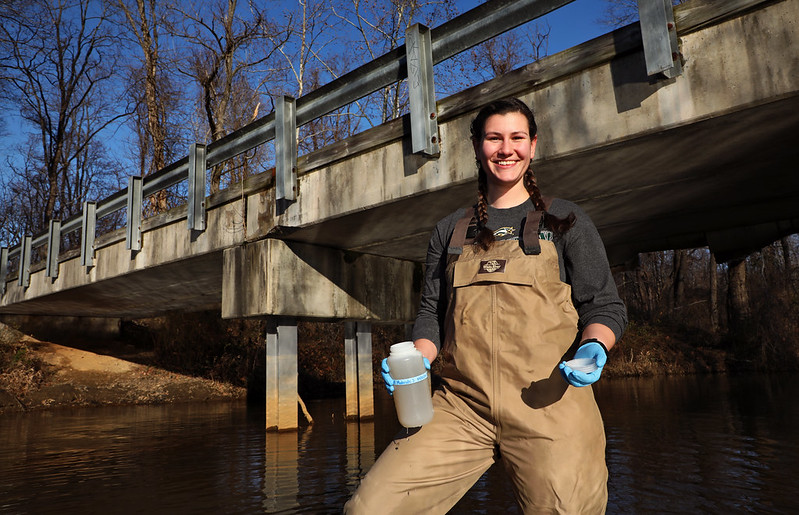Cover photo: Sammie collecting samples, photo by Aileen Devlin, Virginia Sea Grant
Sammie Alexander, a Master’s student of Environmental Science and Policy, is a lead author on her first study, published with Dr. CJ Schlick and Dr. Kim de Mutsert (Read it here). Learn about her journey as a young scientist and researcher and the surprising ways scientific questions can arise.
Written by Sammie Alexander

In spring 2016, I completed an OSCAR Undergraduate Research Scholars Program project under the guidance of Dr. CJ Schlick (then, PhD candidate) investigating the influence of temperature on the growth of young-of-year (YOY) Alewife and Blueback Herring in Potomac River tributaries. At the time, I was a second-year undergraduate and had not yet had much research experience beyond the Honors College course HNRS 110: Principles of Research and Inquiry, wherein I conducted a literature review to answer a research question I had developed. Through the project with Dr. Schlick, I gained hands-on laboratory experience dissecting YOY fish to extract their otoliths for aging using a method similar to counting rings on a tree – each ring on the YOY otolith represented a day of life, so the number of rings equated the number of days since hatching. Once all fish were aged, we then began comparing the determined ages against the known lengths of the fish to then incorporate into a commonly used growth model for fisheries research known as the von Bertalanffy growth function.

We wanted to know if there was evidence to suggest that temperature was driving growth in these two Species of Concern, so we needed to find a way to compare the growth function to known temperatures throughout the study period. After months of trial and error, I received some very helpful feedback at a conference I was presenting a poster at. Another presenter suggested I look into using the growing degree-day (GDD) metric often applied in agricultural science to our fish species, and after doing some research of my own this eventually became one of our primary modes of inquiry. The GDD metric essentially applies a value to each day of life a fish experiences above their known minimum temperature threshold for growth, and then all of the calculated values are added together for the period of time the fish was alive (i.e., we knew the date we collected the fish on and the number of days they were alive, so we could trace back to which day they hatched on and use temperature data from a nearby buoy to calculate the daily GDD values). This method allowed us to analyze the relationship between temperature and growth in our populations of fish sampled between 2013 and 2015.

This was the first of many research projects I would conduct in Dr. Kim de Mutsert’s Fisheries Ecology Lab, and it contributed to my decision to pursue an accelerated master’s at Mason. Following this project, I completed an OSCAR team project in summer 2017 looking at diet composition of fishes in Gunston Cove and Hunting Creek (i.e., two of the areas studied in first OSCAR project), and then began my master’s in Environmental Science and Policy in 2018 using environmental DNA (eDNA) and habitat assessments to evaluate the implications of roadways on stream connectivity and the distributions of native and invasive fish species in northern Virginia. Since becoming a master’s student at Mason, I have served two years as Social Chair for the Environmental Science and Policy Graduate Student Association, become a 2019-20 Catherine and Richard Becker Graduate Research Fellow, and received two program development grants from Virginia Sea Grant. I hope that this manuscript is the first of many reflective of the work I have conducted during my time at George Mason University.

